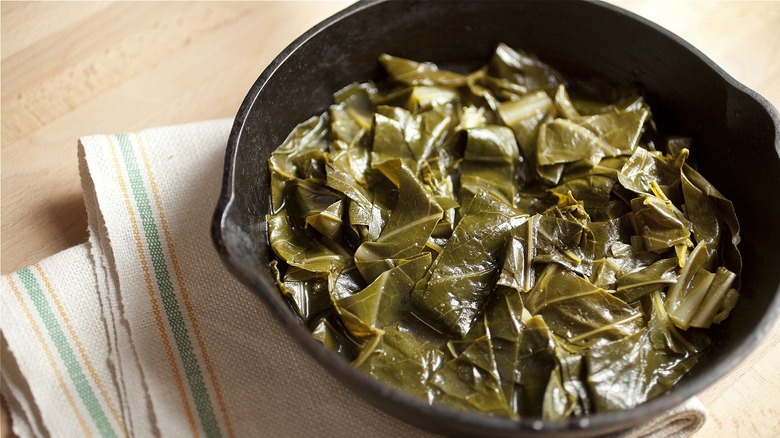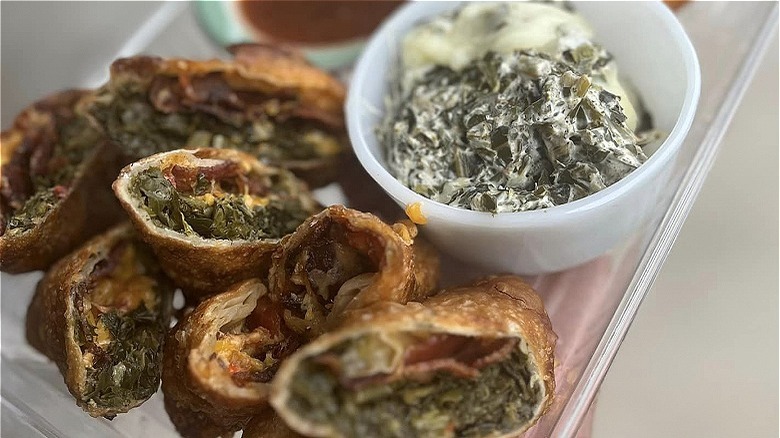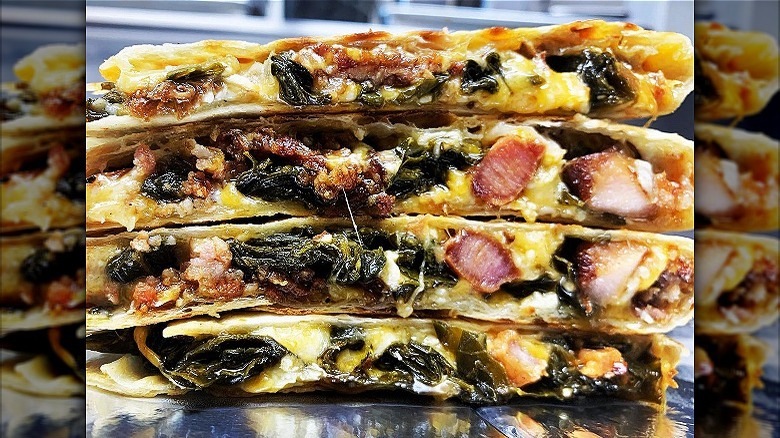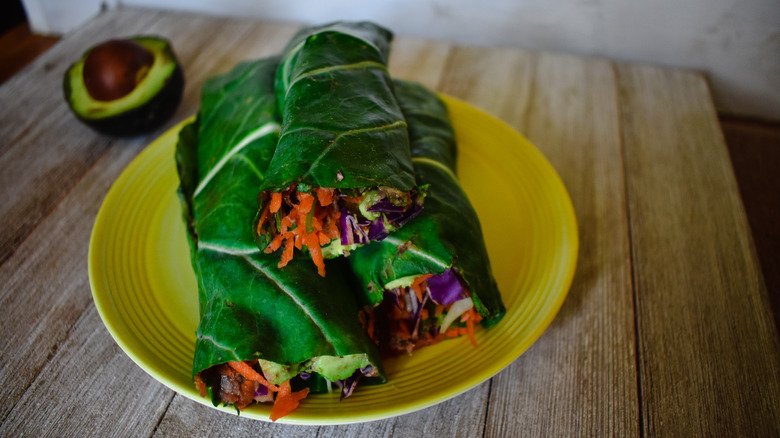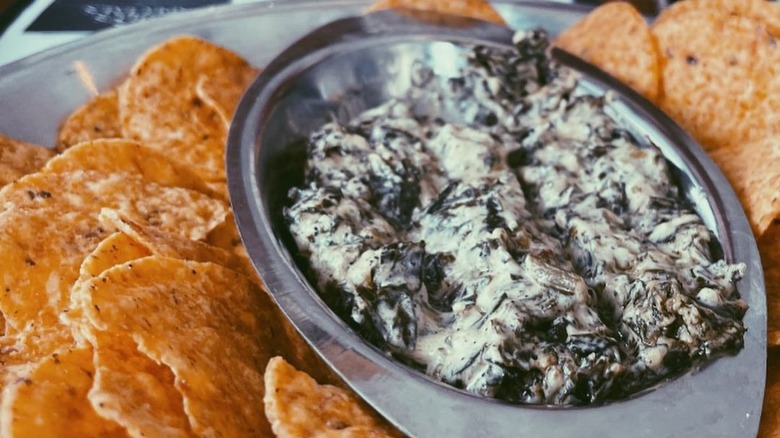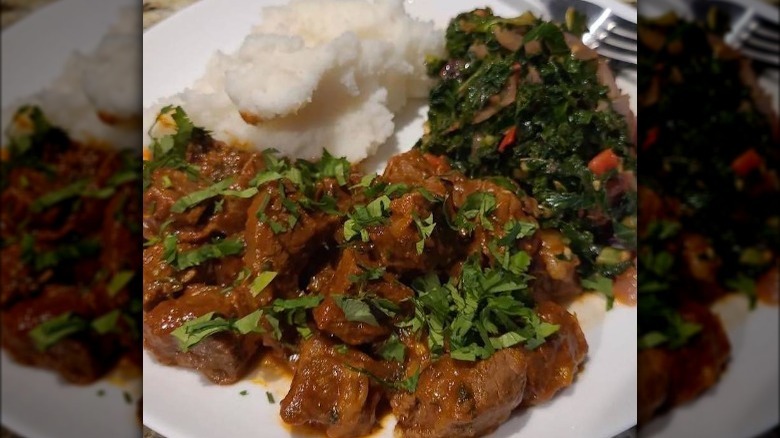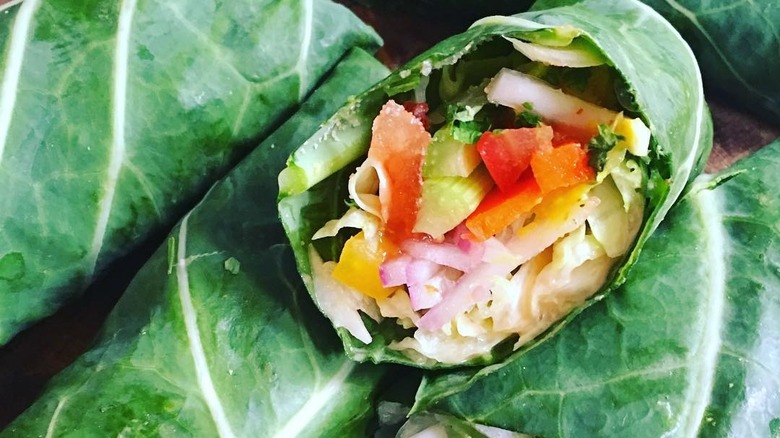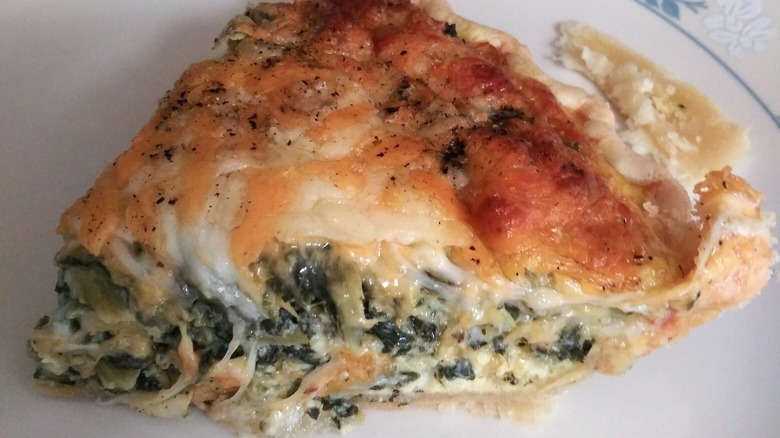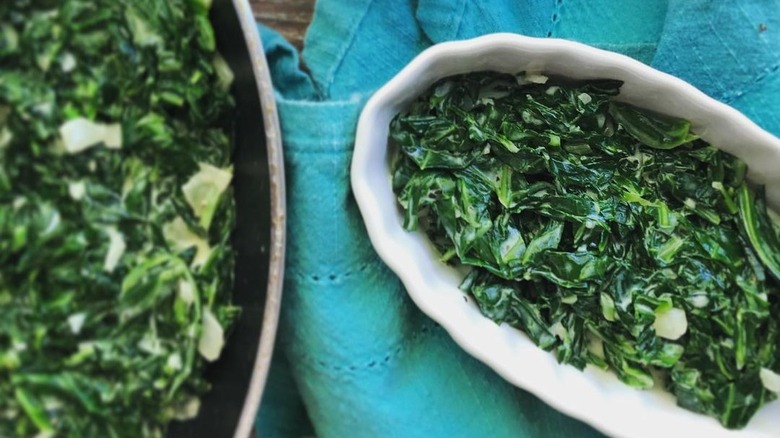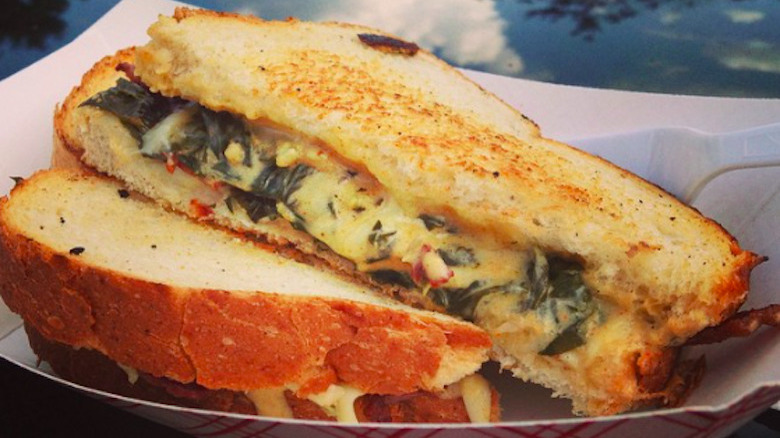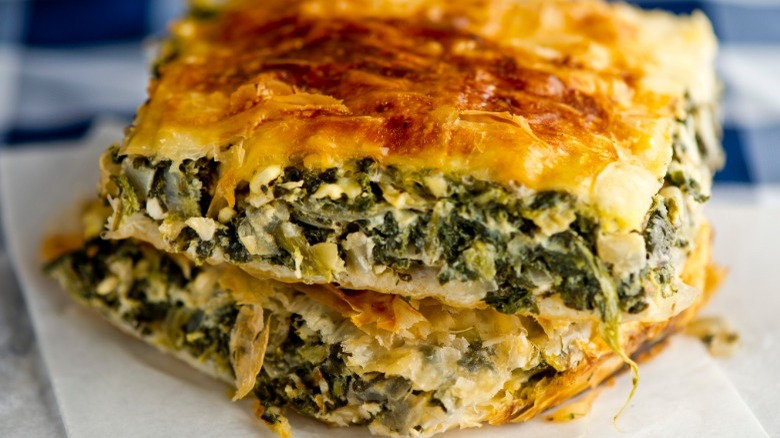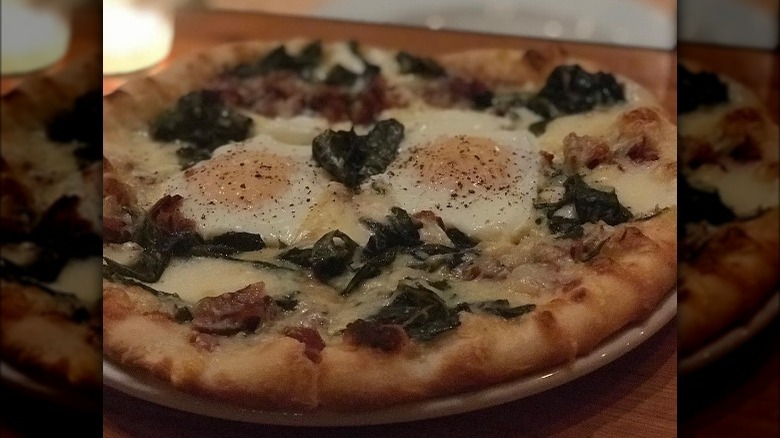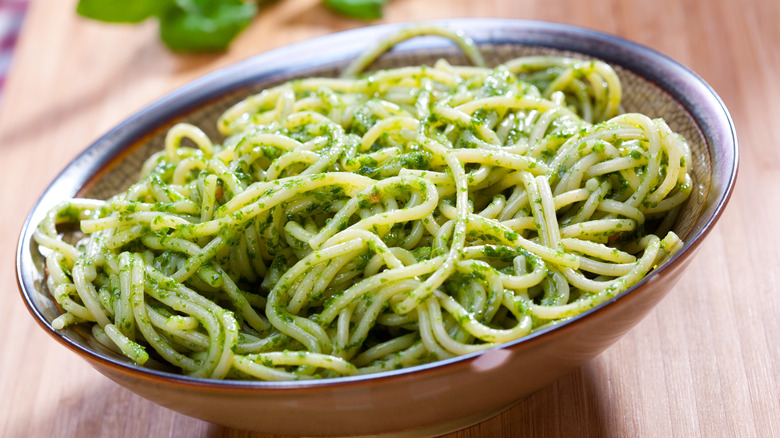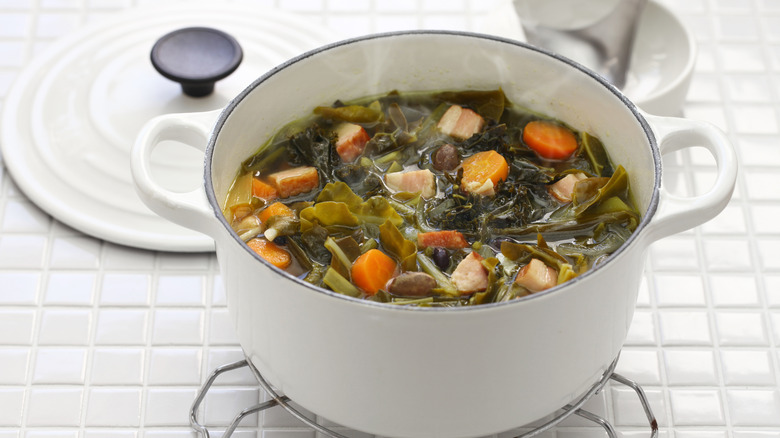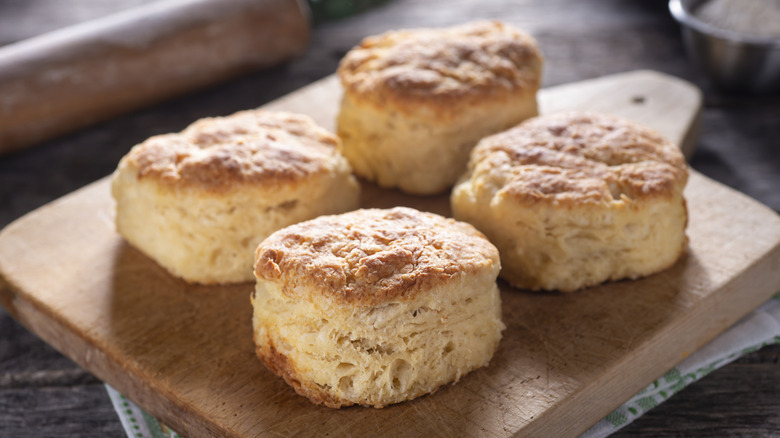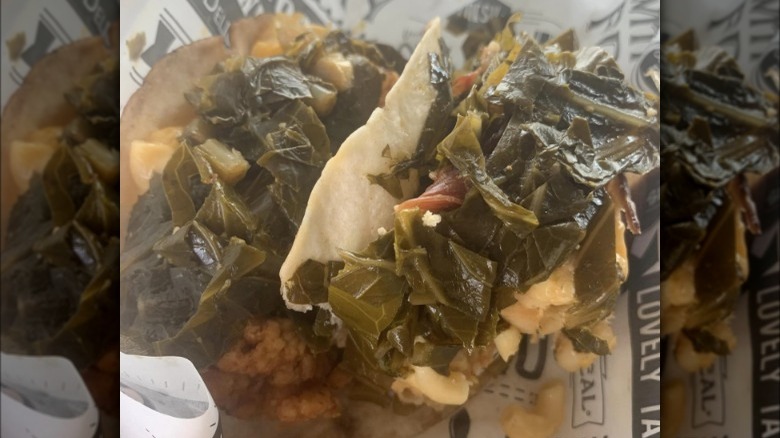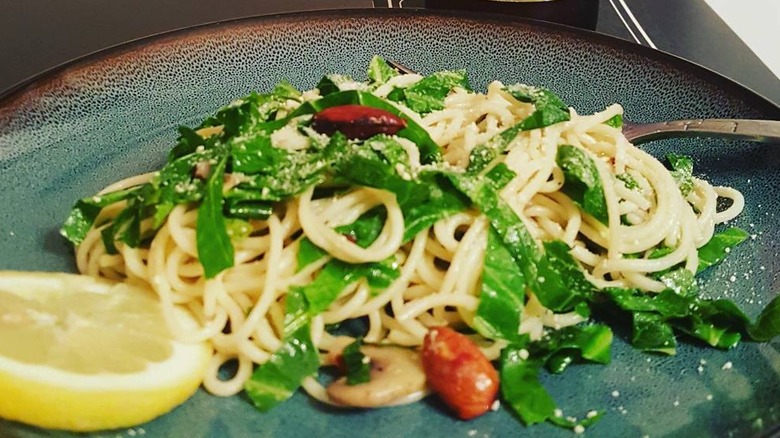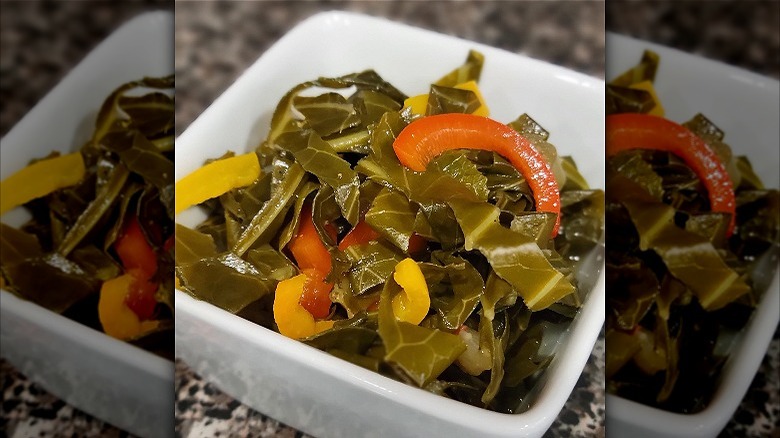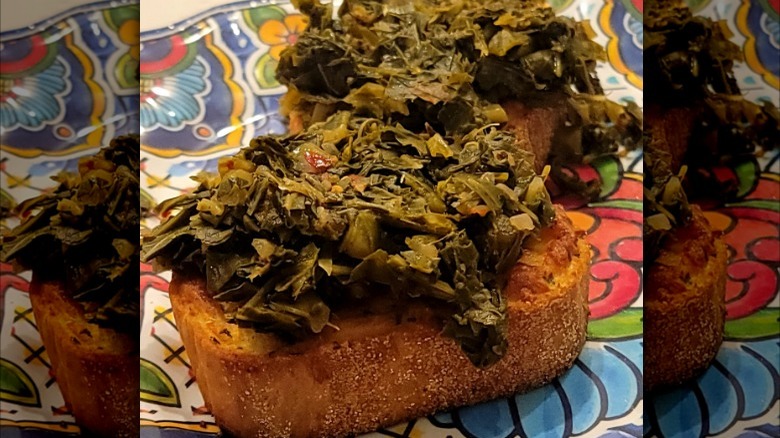18 Unexpected Ways To Use Collard Greens
Southerners have always known that well-seasoned, well-cooked collard greens are perfectly good on their own. Make a big pot of collards, and you don't need anything else to help them along — except perhaps some vinegar and a big hunk of cornbread. Just like pinto beans or chicken and dumplings, collard greens can certainly be served as a side dish or part of a big supper, but plenty of folks are content to make a meal of them in a bowl all by themselves. Today, collard greens are popping up in more inventive recipes and dishes, and in places you may have never expected to see them before.
Now that Southern cuisine is catching on in places north of the Mason-Dixon line, collard greens are getting noticed. Inventive big-city restaurant chefs are incorporating greens into dishes in surprising ways. Southern chefs, too, are embracing the multicultural roots of the South's cuisine, leading to exciting dishes that seem new, but are built on old traditions. While a big ol' pot of collards will always satisfy, here are some of the other ways you can get your collard greens fix.
1. Stuff collards into egg rolls
Egg roll wrappers stuffed with soul food components have been popping up on the menus of food trucks and restaurants in recent years, but to residents of the Deep South, they're not all that new. The "soul rolls," as they're often called, arose from the blending of Chinese-American and Black food traditions during the segregation era. Chef Michael W. Twitty has written about kosher soul rolls, integrating his own Jewish roots into the dish, and even late rapper Coolio had a version in his "Cookin' with Coolio" cookbook.
Soul rolls start with a basic egg roll wrapper, then they're filled with Southern-style ingredients like pulled pork, macaroni and cheese, and collard greens before deep-frying. Collard greens make a great egg roll stuffing even without the other accompaniments, especially if they're cooked with plenty of pork. Serve with a zesty remoulade, pimiento cheese, or barbecue sauce for dipping.
2. Green up a quesadilla
As delicious as your collard greens recipe might be, sometimes you might tire of them before you finish off the whole pot. A brilliant use for leftover collard greens is to repurpose them as a filling for a quesadilla. Collard greens pair surprisingly well with cheese, which should be no surprise, given their frequent proximity to macaroni and cheese on many a Southern plate. Most people don't complain if they happen to get a little mixed up.
The Bandito Burrito Truck in Greensboro, North Carolina has featured a bacon and collard quesadilla as one of their specials, and you can easily replicate the dish at home if you're not local to the area. Be sure and drain your collard greens well before topping your tortilla, add plenty of cheese, and grill until golden for some Tex-Mex-soul goodness.
3. Use collard leaves as wraps
Gluten-free advocates, dieters, and vegans all rejoice over flourless and low-carb alternatives to bread products, but there are even more reasons to embrace collard green leaves as wraps. One of those reasons is nutrition. Raw collards are even more nutritious than cooked, with hefty amounts of folate, antioxidants, and more than a day's worth of vitamin K. Using collard leaves can make an already-healthy wrap into a nutrient powerhouse.
The other reason? Color! Raw collard leaves are simply beautiful, and when stuffed with other colorful veggies, they're like art on a plate. Choose ingredients with color and contrast in mind: matchstick carrots, pineapple chunks, avocado, beets, peppers, and sprouts all make fantastic fillings. Be mindful of the thick stem, and trim the leaves before blanching briefly in boiling water to soften the greens.
4. Mix up a creamy dip
No one can resist a creamy party dip, but fans of Southern cuisine should find it even harder to resist their favorite spinach dip recipe if it's made with collard greens instead. Both sour cream and onion dip-style recipes and hot, cheesy baked dip recipes work every bit as well with zesty collards. Vidalia onions and crispy bacon are perfect add-ins to maximize the flavor.
You can also adjust the seasonings to be even more Southern if you like. Your favorite Cajun seasoning blend will help heat up your collard greens dip, or stir in some chili flakes or your favorite hot sauce. You can choose whatever you like for dipping — even fried pork rinds. Tea-sized biscuits or celery sticks are also good choices, but no one will complain about your favorite chips or crackers.
5. Bring color to a stir fry or curry
Most every stir fry can benefit from a little greenery for contrast, but so many of them seem to lean on the same old staples of broccoli and snow peas. Try collard greens for a new way to add green to any stir fry dish. The flavor of collard greens also pairs well with many stir fry ingredients, especially pork and chicken. Vegetarians will love the pairing of collards and tofu.
Collard greens and coconut milk make up one of the most popular dishes in Kenya, so it stands to reason that collards work well with coconut-based skillet dishes, whether African, Thai, Hawaiian, or Indonesian. Curry dishes can also benefit from the addition of collard greens, and they work especially well in fiery hot versions with lots of peppers.
6. Switch up your cabbage rolls
If cabbage rolls are part of your dinner repertoire, consider switching things up by using collard greens in place of the more-traditional cabbage. You can keep your favorite recipe and use the same filling (usually ground beef and rice). The chunky tomato sauce that typically tops cabbage rolls works just as well atop bright green collards — and it offers a beautiful contrast, too.
Of course, you could always stuff your collard green rolls with something a bit more soulful and Southern. Try using ground pork instead of beef and integrating Cajun seasons. Pulled pork or chicken would work well, too, or black-eyed peas for vegetarians. At the Fog Eater Café in Mendocino, California, the collard rolls are stuffed with New Orleans-style dirty rice and topped with a peanut miso and chow chow relish. How's that for inventive?
7. Bake a collard quiche
Quiche is such a perfect dish for any meal — straddling the line between breakfast food and anytime food — but the fillings can be a bit predictable. Everyone's seen spinach quiche on a billion menus, but collard greens are much more rare, making them an intriguing addition that gives an instant Southern flare. (Just as you would with spinach, be sure and drain collard greens well before incorporating them into a quiche.) Keep the menu on-theme with a side of cheese grits and a slice of salty country ham.
You can keep it even simpler by skipping the quiche and just scrambling leftover collard greens with eggs. Scrambled eggs and collards don't have to be fancy, and you can whip them up for yourself on a lazy weekend. Add plenty of cheese and you're good to go. Sharp cheddar is an especially good choice for collards, and don't forget the hot sauce!
8. Cream collards like spinach
If you haven't caught on yet, anywhere spinach can go, collard greens can, too. (That's why they're so great in dips, quesadillas, and quiches.) That means that you can also cream collards the same way you would make creamed spinach. Creamed collards are a delicious way to introduce the leafy greens to those who might be suspicious of them (like children, who are often wary of anything the color of broccoli). The addition of cream — and possibly even cheese — can convert even the most persnickety eaters.
For those who already know the virtues of collard greens, you don't need for it to be disguised, but creamed collards are still a good choice of side dish when you want a rich contrast to a lighter main dish, like fish or grilled chicken. You can also use collard greens in your favorite spinach gratin dishes, adding a crunchy topping of bread or panko crumbs.
9. Add soul to a grilled cheese
Cooking a pot of collard greens takes time and patience. Once you've cooked them, though, they're there for using, and when you want a quick meal or something to cure those middle-of-the-night munchies, don't ignore them. The collard green grilled cheese is one of those creations that's exactly what you need it to be when you happen to crave it. The hot, gooey, stretchy cheese, the buttery toasted bread, and the spicy greens create a harmony that heaven could only dream of.
If you think that sounds over the top, then you haven't yet tried adding collards to a grilled cheese. Drop everything and do it. As mentioned in other suggestions above, drain your collards well (on a paper towel, if necessary) and get to grilling. You don't need much — just bread, butter, cheese, and collard greens — but you can tweak it to your own taste. Artichokes, roasted peppers, and kraut are all fine additions. (Some folks use collard greens as the filling on a vegetarian reuben sandwich because it tastes so good with sauerkraut.)
10. Make a Southern spanakopita
The beauty of fusion cooking is the bringing together of two seemingly disparate cuisines into one unified dish. Once you know a bit about food history, though, it's really hard to find cuisines that truly are disparate. Nearly every food tradition has collided with another, as people have immigrated all over the world. Still, it's fun to mix and match traditional dishes of different cultures, especially if it brings new foods to your family's table that might be unfamiliar to them.
Adding collard greens to Greek spanakopita is a great way to bring Mediterranean food to your Southern family. Or, to bring Southern food to your Greek family. Either way, it's a dish that works, because the flavors just make sense together. Tip: If your kids aren't big fans of feta cheese, try a milder one, like mozzarella. You're already using collards instead of spinach, so the rules are out the window.
11. Top a pizza
Is there anything that doesn't belong on pizza? (Some might answer "pineapple," but jokes aside, plenty of people enjoy it as a topping.) One of the most wonderful things about pizza is its chameleon-like nature, transformed into whatever its maker (and its eater) want it to be. That's why popular pizza toppings vary from country to country, and from person to person.
Collard greens absolutely do belong on pizza, and they taste great with traditional tomato sauce and cheese. They can also be part of a more Southern-style pizza, with a barbecue sauce base and a topping of smoked cheese (smoked mozzarella or cheddar are great choices). A cornmeal crust can make a collard-topped pizza even more Southern, but traditional crust is fine, too.
12. Learn a new twist on pesto
Pesto is such a versatile sauce, and it lends wonderful color and flavor to all kinds of dishes. While fresh basil is the usual basis for pesto, collard greens are a nifty replacement. In fact, don't think of them as a substitute. Think of collard pesto as its own kind of sauce, imparting a snappy taste to any dish that could use brightening up, while also giving it some Southern sass.
Swap chopped collard leaves for basil in your favorite pesto recipe, cup for cup. You can keep the rest of the ingredients the same, but some chefs like to use pecans in place of pine nuts, as they're more readily available in the South. Add collard pesto to cooked pasta dishes, stir some into scrambled eggs, or mix with mayonnaise for a collard aioli you can spread on sandwiches.
13. Simmer collards with soups and stews
Almost any soup could benefit from the addition of collard greens. Soup is already revered for its ability to warm and nourish during cold months, and collards can make even the most healthy soup that much more nutritious. Toss collard greens into the pot when you're making "anything goes" types of soups — like minestrone or vegetable soup — for color and substance. You can also get rid of some of your less-than-perfect leaves this way.
Collard greens are especially good with autumn soups and stews, like those with butternut squash, sweet potato, or pumpkin as a base. You can also try kale in potato leek soup or any kind of creamed soup. If you like broccoli and cheese soup, try collards and cheese. Though not exactly traditional, you can boost the powers of chicken soup with some collard leaves.
14. Serve on a biscuit
Nothing beats a hot buttermilk biscuit, except perhaps a hot buttermilk biscuit topped with something deliciously Southern. While country ham, sausage, eggs, or skillet gravy are all good toppings for a biscuit, don't neglect collard greens the next time you have a naked biscuit on your hands. Leftover collards and biscuits are a real treat, and while they make a nice impromptu breakfast, they're also perfect for late-night snacking.
If you happen to make your collard greens vegetarian, collards-on-a-biscuit are a welcome breakfast sandwich alternative for your vegetarian friends. And as long as they're not vegan, remember that collards and eggs make great companions, as mentioned above. For non-vegetarians, collards can share biscuit space with short ribs, pulled pork, or leftover barbecued chicken.
15. Fill a taco
Southern American cuisine always blends well with Mexican cuisine, because there are a lot of shared staple ingredients, like corn and beans. Anything that's good with cornbread is going to be just as good with a corn tortilla, for example. Collard greens make a unique taco filling on their own, or paired with meat fillings like pork, brisket, ground beef, or chicken.
Collards greens can go beyond tacos if you're craving Mexican fusion. As previously mentioned, quesadillas are another option, but you can also load collard greens onto a tostada or into a burrito. How about some nachos? Pulled pork, collard greens, some smoky melted cheese, and tortilla chips would make a great shareable snack — plus, the collards add a healthy touch to any meal.
16. Pair with pasta and noodle dishes
Pasta is one of those kinds of dishes where almost anything goes. Toss some spaghetti with a bit of this and a little of that, and you've got dinner on the table. You may not have thought of adding collard greens to your pasta dishes, though. Next time you're looking for a way to change up your pasta, try collard greens. They work well with a simple lemon and garlic dressing, but can also add heft to a meaty, saucy, baked lasagna.
Asian noodle bowls can also benefit from the addition of collard greens. Buckwheat soba noodles are a great partner to collards, or you can add them to your next ramen bowl creation. Chef Todd Richards' pork ramen recipe uses collard greens, smoked bacon, and ham hocks for flavor.
17. Pickle your collards
You already know that collard greens taste great with vinegar. If that vinegar-y tang is your favorite part of the collard greens experience, why not take it to another level by pickling them? Pickling brine helps soften even the toughest of greens, and it also ensures you can have your collards preserved and ready to eat even when they're out of season.
You can adjust your pickling recipe to your own taste. Some people like to add extra heat to their pickled collards, while some swear by a pinch of sugar. After pickling, you can snack on your greens, serve them as part of a relish tray, or use them to add flavor to sandwiches. (Anything you can do with a pickle, you can do with pickled collard greens.)
18. Try some on toast
Move over, avocado toast, there's a new green toast-topper in town. Collard greens on toast may be considered advanced-level Southern fusion, for only the most die-hard fans of collard greens, but it is no gimmick. Collard greens taste great on dense, rustic toast (think pumpernickel or multi-grain), and their peppery, vinegary flavor make a great base for other toppings.
If you think about how collard greens work great in a grilled cheese, then having them on toast truly does make sense. Try pairing them with a sprinkling of crumbled bacon, some smoked cheese, or thinly-sliced Vidalia onion. Serve some for brunch with a side of fried potatoes and onions and a big pitcher of sweet tea, for a truly Southern spread.
